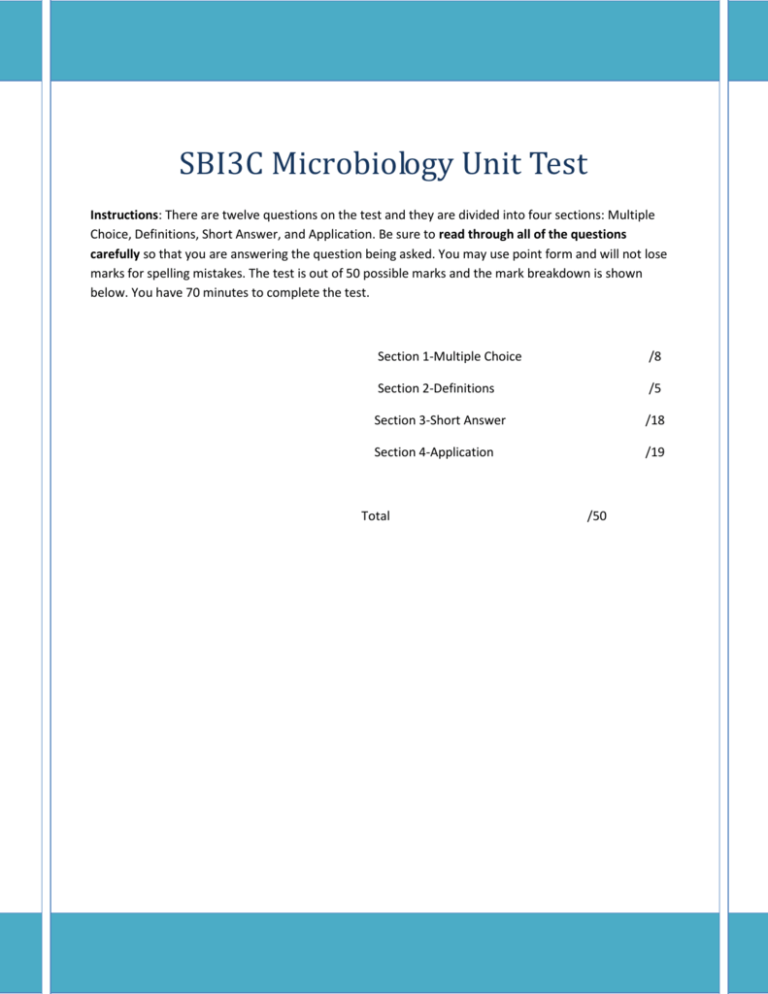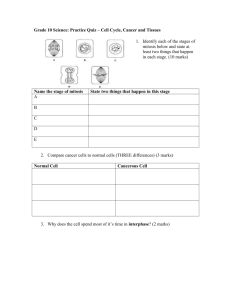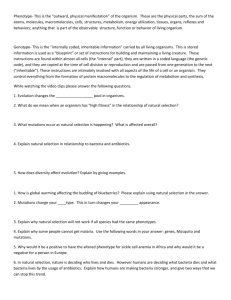SBI3C Microbiology Unit Test with Solutions
advertisement

SBI3C Microbiology Unit Test Instructions: There are twelve questions on the test and they are divided into four sections: Multiple Choice, Definitions, Short Answer, and Application. Be sure to read through all of the questions carefully so that you are answering the question being asked. You may use point form and will not lose marks for spelling mistakes. The test is out of 50 possible marks and the mark breakdown is shown below. You have 70 minutes to complete the test. Section 1-Multiple Choice /8 Section 2-Definitions /5 Section 3-Short Answer /18 Section 4-Application /19 Total /50 Section 1-Multiple Choice Select the best answer. Some questions ask you to explain your answer. 1. Which of the following is not a characteristic of fungi: Explain your choice a. Have ability to reproduce asexually and sexually b. Eukaryotic c. Colonial cellular arrangement d. Chemoheterotrophic /2 Explanation: Fungi can have unicellular, filamentous, or fleshy cellular arrangements but not colonial cellular arrangements. 1 mark for correct choice 1 mark for correct explanation (K/U, T) 2. What was the source of E. coli during the Walkerton Tragedy? Explain your choice. a. raw chicken b. canned ham c. Runoff of manure from a local farm d. Shellfish /2 Explanation: E.coli entered the town water supply after a period of heavy rains caused runoff from a local farmer’s field to drain into a town well. The runoff water was contaminated with E.coli from manure that was spread on the field. 1 mark for correct choice 1 mark for correct explanation (K/U) 3. Which of the following statements is true: a. Meiosis involves crossing over between homologous chromosomes b. mitosis results in haploid daughter cells c. mitosis occurs during binary fission d. meiosis only occurs in prokaryotic cells 1 mark for correct choice (K/U) 4. Bacteria reproduce by: a. Binary fission b. Mitosis c. Meiosis d. Endospores /1 /1 1 mark for correct choice (K/U) 5. An organism that grows best in salty conditions is known as: Explain your choice. a. A mesophile b. A thermophile c. A halophile d. An extremophile /2 Although a halophile could be considered an extremophile because it grows under extreme conditions the more specific name for this type of organism is halophile. 1 mark for correct choice 1 mark for logical explanation (K/U, T) Section 2-Definitions 6. Define only 5 of the following terms. /5 Intestinal Flora-the diverse range of bacteria that inhabit the intestinal tract Microbiology-the study of microorganisms Microorganism-a living organism too small to be seen with the naked eye Vaccine-A preparation of killed, inactivated, or attenuated microorganisms to induce artificially acquired immunity HIV- human immunodeficiency virus; a retrovirus that causes AIDS Bacteria-Kingdom of prokaryotic organisms, characterized by peptidoglycan cell walls Pathogen-a disease causing organism Motility-the ability of an organism to move by itself 1 mark for each correct definition (K/U) Section 3-Short Answer 7. Complete the following chart indicating the differences between prokaryotic and eukaryotic organisms: /8 Characteristic Cell Wall Prokaryotic Complex, contain peptidoglycan Membrane enclosed organelles Nucleus Reproduction absent No true nucleus Binary Fission Eukaryotic chemically simple, no peptidoglycan Present, e.g. lysosomes, mitochondria True nucleus Usually divide by mitosis 1 mark for each correctly completed cell (K/U, T) 8. Explain the difference between a bacterial endospore and a fungal spore. /4 A bacterial endospore forms inside a bacterial cell in response to adverse environmental conditions. This is not a method of reproduction rather it is a method of preservation of the cell. Fungal spores are a reproductive structure that can be either asexual or sexual. Fungi can be identified based on spore type. 2 marks for each description (K/U, T) 9. Why do antibiotics kill bacteria but not human cells? Provide one specific antibiotic example and describe how it works on the bacterial cell. /6 Bacteria, unlike human cells, contain peptidoglycan in their cell walls they also have different metabolic processes than human cells. These cellular differences are what make human cells resistant to antibiotics while bacterial cells are killed or prevented from multiplying. Penicillin interferes with a cells ability to synthesize peptidoglycan which is necessary for bacteria to build a strong cell wall. Without the strong cell wall, the cell bursts and is destroyed. Sulfonamide antibiotics act to prevent microorganisms from reproducing by inhibiting their ability to synthesize folic acid. Folic acid is necessary for the survival of the cell and therefore the cell cannot reproduce and eventually dies. Human cells are unaffected as they are able to take in folic acid through diffusion. 2 marks for correct response to first question 2 marks for correct example (K/U, T, A) Section 4-Application 10. Do you think a virus a living or non-living organism? Provide evidence that supports your argument. Using opposing evidence, describe why some people argue against what you think. /5 Living Contain DNA-the building blocks of life Like other living organisms they evolved Has the potential to reproduce Non-living Cannot reproduce independently Require energy from the host to perform metabolic processes Exhibit no activity indicative of life when not in contact with host 1 mark for each factual logical point in the argument up to five points (T/I, A) 11. What causes food poisoning? Using your knowledge of optimal growth conditions and food handling explain how you can prevent food poisoning caused by fresh food products. /8 Food poisoning is caused by consuming food products that is contaminated with certain bacteria that are harmful to human health such as E.coli and Salmonella. 2 marks for describing causes of food poisoning The growth of bacteria on foods can be limited by manipulating optimal growth conditions such as temperature and oxygen requirements. It is also necessary to observe proper food handling techniques to prevent the spread of bacteria from one location to another. It is through manipulating these conditions that food poisoning can be prevented. 2 marks for describing optimal growth conditions Fresh food is stored using Refrigeration as this acts to manipulate the environmental temperature. The temperature is reduced thereby inhibiting further growth of microorganisms present on food. Placing food in sealable containers limits the amount of oxygen available to microorganisms and therefore limits their growth. Cooking food at high temperatures also acts to kill certain types of harmful bacteria. Washing hands and ensuring that cross-contamination of cookware does not occur is important to limit the spread of contaminants such as Salmonella from raw chicken. 4 marks for explanation about how to use optimal growth conditions to prevent food poisoning (K/U, T, A) 12. Classify the following cells as Algae, Fungi, Bacteria, or Virus. Explain your classification choice based on the characteristics of the cells. /6 a. Algae: green colour indicates presence of chloroplasts (photosynthesis); eukaryotic as indicated by presence of nucleus b. Virus: protective shell enveloping the cell with possible spikes, no visible nucleus or any type of internal structure 1 mark for each correct classification 2 marks for explanation that matches students’ classification (do not penalize if classification is wrong as long as the explanation corresponds to the students’ choice of classification) (K/U, A)







